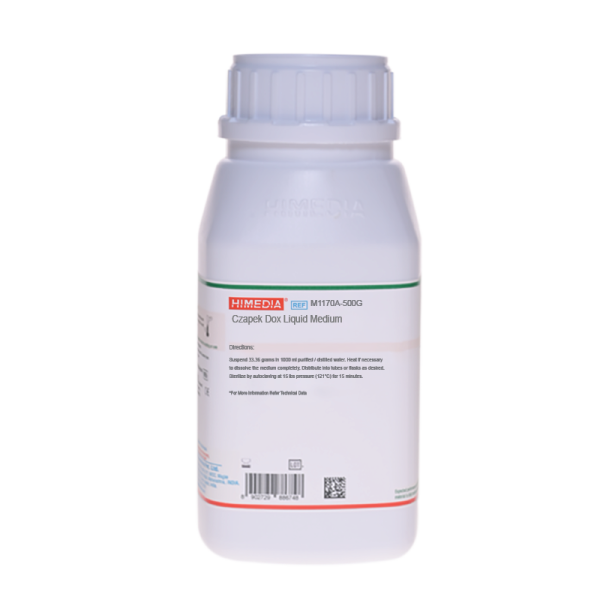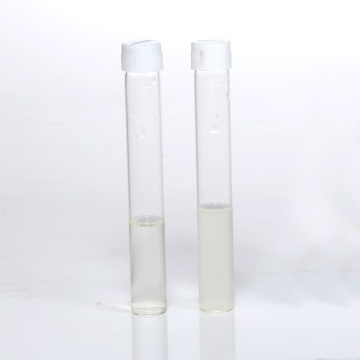 Your enquiry has been submitted
Your enquiry has been submitted
Czapek Dox Liquid Medium
Intended Use
Recommended for the cultivation of fungi and bacteria capable of utilizing sodium nitrate as the sole source of nitrogen.
Composition
| Ingredients | Gms / Litre |
|---|---|
| Sucrose | 30.000 |
| Sodium nitrate | 2.000 |
| Magnesium glycerophosphate | 0.500 |
| Potassium chloride | 0.500 |
| Dipotassium sulphate | 0.350 |
| Ferrous sulphate | 0.010 |
Final pH (at 25°C): 6.8±0.2
**Formula adjusted, standardized to suit performance parameters
Directions
Suspend 33.36 grams in 1000 ml purified / distilled water. Heat if necessary to dissolve the medium completely. Distribute into tubes and sterilize by autoclaving at 15 lbs pressure (121°C) for 15 minutes.
Principle And Interpretation
Czapek Dox Agar, Modified supports the growth of organisms which are able to utilize sodium nitrate as the sole source of nitrogen. It is also used for the cultivation and maintenance of numerous fungal species and also for chlamydospore production by Candida albicans (1). The medium has been recommended by various authours for studies of Aspergillus, Penicillium and Actinomycetes (4,5,6,7). Czapek Dox Liquid, Modified serves the same purpose as Czapek Dox Agar Modified.
Sodium nitrate is the sole source of nitrogen while sucrose is the sole source of carbon. Magnesium glycerophosphate and potassium sulphate help in chlamydospore production by C. albicans.
Type of specimen
Organic matter samples.
Specimen Collection and Handling:
For organic matter samples, follow appropriate techniques for sample collection, processing as per guidelines and local standards.
- After use, contaminated materials must be sterilized by autoclaving before discarding.
Warning and Precautions :
Read the label before opening the container. Wear protective gloves/protective clothing/eye protection/ face protection. Follow good microbiological lab practices while handling specimens and culture. Standard precautions as per established guidelines should be followed while handling specimens. Safety guidelines may be referred in individual safety data sheets.
Limitations :
- Further biochemical and serological tests must be carried out for further identification.
Performance and Evaluation
Performance of the medium is expected when used as per the direction on the label within the expiry period when stored at recommended temperature.
Quality Control
Appearance: White to light yellow homogeneous free flowing powder
Colour and Clarity of prepared medium: Light yellow coloured, clear to slightly opalescent solution
Reaction: Reaction of 3.33%w/v aqueous solution at 25°C. pH : 6.8±0.2
pH: 6.60-7.00
Cultural Response
Cultural characteristics observed after an incubation at different temperatures for 24-48 hours.
| Organism | Growth | Incubation temperature |
|---|---|---|
| Aspergillus fumigatus ATCC 1028 | luxuriant | 50°C |
| #Aspergillus brasiliensis ATCC 16404 | luxuriant | 30°C |
| Candida albicans ATCC 10231 | luxuriant (Chlamydospores formation) | 28°C |
| Pencillium notatum ATCC 10108 | luxuriant | 20-25°C |
| Saccharomyces cerevisiae ATCC 9763 | luxuriant | 25-30°C |
Key:
# - Formerly known as Aspergillus niger
Storage and Shelf Life
Store between 10-30°C in a tightly closed container and the prepared medium at 15-25°C. Use before expiry date on the label. On opening, product should be properly stored dry, after tightly capping the bottle in order to prevent lump formation due to the hygroscopic nature of the product. Improper storage of the product may lead to lump formation. Store in dry ventilated area protected from extremes of temperature and sources of ignition. Seal the container tightly after use. Use before expiry date on the label. Product performance is best if used within stated expiry period.
Disposal
User must ensure safe disposal by autoclaving and/or incineration of used or unusable preparations of this product. Follow established laboratory procedures in disposing of infectious materials and material that comes into contact with clinical sample must be decontaminated and disposed of in accordance with current laboratory techniques (2,3).
Reference
- Dawson and Christine O., 1962, Saboutaudia; 1:214.
- Isenberg, H.D. Clinical Microbiology Procedures Handbook 2nd Edition.
- Jorgensen, J.H., Pfaller, M.A., Carroll, K.C., Funke, G., Landry, M.L., Richter, S.S and Warnock., D.W. (2015)3 Manual of Clinical Microbiology, 11th Edition. Vol. 1.
- Raper K. B. and Thom C., 1949, Manual of Penicillia, Williams and Wilkins Co., Baltimore.
- Thom C. and Church M. B., 1926, The Aspergilli, Williams and Wilkins Co., Baltimore.
- Thom C., 1930, The Penicillia, Williams and Wilkins Co., Baltimore.
- Wakesman S. A., 1931, Principles of Soil Microbiology, Bailliere Thindall and Co., London.
| Product Name | Czapek Dox Liquid Medium |
|---|---|
| SKU | M1170A |
| Product Type | Regular |
| Physical Form | Powder |
| Origin | Chemically defined |
| Packaging type | HDPE |
| References | 1. Dawson and Christine O., 1962, Saboutaudia; 1:214. |
| Customized Product Available | No |





